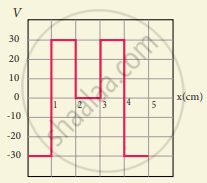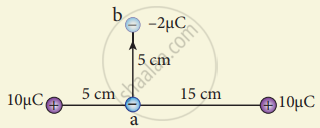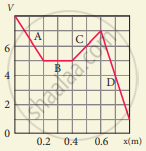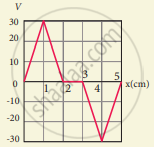Advertisements
Advertisements
प्रश्न
The electrostatic potential is given as a function of x in figure (a) and (b). Calculate the corresponding electric fields in regions A, B, C and D. Plot the electric field as a function of x for figure (b).
उत्तर
Figure a:
`vec"E" = - "dv"/"dx" hat"i"`
From 0 to 0.2 m,
`"E"_"x" = "dv"/"dx" = 3/0.2 = 30/2 = 15`Vm-1 (region A)
`"E"_"x" = "dv"/"dx"` = 0
Since the potential is constant (region B)
`"E"_"x" = "dv"/"dx" = (-2)/0.2 = (-20)/2` = - 10 Vm-1 (region c)
`"E"_"x" = "dv"/"dx" = 6/0.2 = 60/2` = 30 Vm-1 (region d)
Figure b:

`"E"_"x" = "dv"/"dx"` = - 30 Vm-1 (region 0-1 cm)
`"E"_"x" = "dv"/"dx"` = 30 Vm-1 (region 1-2 cm)
`"E"_"x" = "dv"/"dx"` = 0 (region 2-3 cm)
`"E"_"x" = "dv"/"dx"` = 30 Vm-1 (region 3-4 cm)
`"E"_"x" = "dv"/"dx"` = - 30 Vm-1 (region 4-5 cm)
APPEARS IN
संबंधित प्रश्न
Which charge configuration produces a uniform electric field?
An electric field `vec"E" = 10 xx hat"i"` exists in a certain region of space. Then the potential difference V = Vo – VA, where Vo is the potential at the origin and VA is the potential at x = 2 m is:
Two points A and B are maintained at a potential of 7 V and -4 V respectively. The work done in moving 50 electrons from A to B is ______.
Define electrostatic potential.
What is an equipotential surface?
What are the properties of an equipotential surface?
Define ‘electrostatic potential energy’.
The total number of electrons in the human body is typically in the order of 1028. Suppose, due to some reason, you and your friend lost 1% of this number of electrons. Calculate the electrostatic force between you and your friend separated at a distance of lm. Compare this with your weight. Assume the mass of each person is 60kg and use point charge approximation.
A spark plug in a bike or a car is used to ignite the air-fuel mixture in the engine. It consists of two electrodes separated by a gap of around 0.6 mm gap as shown in the figure.

To create the spark, an electric field of magnitude 3 x 106Vm-1 is required,
- What potential difference must be applied to produce the spark?
- If the gap is increased, does the potential difference increase, decrease or remains the same?
- Find the potential difference if the gap is 1 mm.
A point charge of +10 µC is placed at a distance of 20 cm from another identical point charge of +10 µC. A point charge of -2 µC is moved from point a to b as shown in the figure. Calculate the change in potential energy of the system? Interpret your result.



